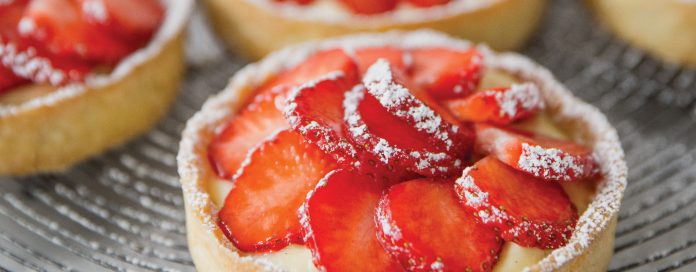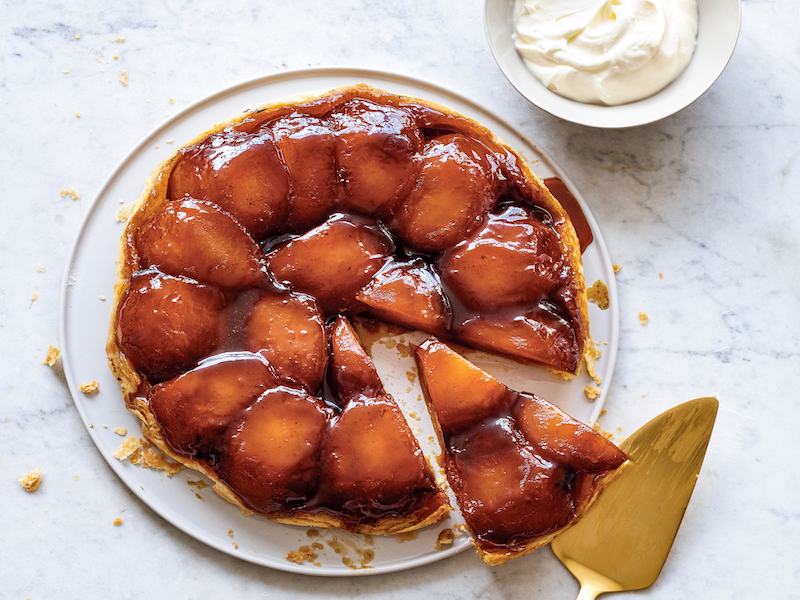
Bienvenue to our March/April 2019 issue. We’ve traveled to France many times, and we return for a deeper dive into custard, cake, and crème. We spotlight tarte Tatin, our caramelized cover star, and explore new ways to make the most of our copper bakeware. Come along as we travel to Burgundy to learn rustic French recipes from The Cook’s Atelier, and join us in an afternoon of baking with David Lebovitz and Dorie Greenspan. From our guide on pâte à choux to a collection of pâtisserie-inspired layer cakes, this issue will be your passport to baking à la française.
Scroll through for an exclusive recipe share from the issue!

- Éclairs
The term éclair translates literally to “flash of lightning,” a reference to how quickly these oblong treats are eaten. Our version is a decadent chocolate affair, with a glossy Chocolate Glaze and silky cocoa crème mousseline filling.

2. Citron Cake
The tarte au citron by Frank Barron of Cake Boy Paris is a testament to the French love of simplicity. Made of lemon curd filling in a pâte sablée, it’s topped with meringue and nothing else. This layer cake plays up the original with lemon cake layers, Meringue Buttercream, and a tart Lemon Curd center. Decorate with dollops of brûléed meringue for an American take on this pâtisserie staple.

3. Pain au Raisin Sweet Rolls
This is our sweet roll take on the laminated classic. Baked to tall, golden perfection in copper soufflé molds, these scrolls are a home baker-friendly version of the original, with an easy-to-use frangipane filling replacing the crème pâtissière.

4. Strawberry Tartlets with Soft Cream
In this rustic recipe by The Cook’s Atelier, use the tiniest strawberries available when preparing these tartlets. Be sure not to overfill the tarts with the pastry cream as you want a nice balance between the cream and the fruit. Like all tarts, they are best eaten the day they are made.

5. Classic Apple Tarte Tatin
Susan Spungen first became a true expert at making tarte Tatin while she was working on the movie Julie & Julia. It was a quick shot, but she worked hard to get the right look and technique so she could make it over and over again and have it look exactly the same each time, which is essential for a movie scene. Making a good apple tarte Tatin is all about technique. The ingredients are simple: apples, butter, vanilla, and sugar. Choosing an apple that holds its shape well is also important.

Meaning “a thousand layers” in French, the mille-feuille is known for its seemingly countless layers of puff pastry. With a dash of crème fraîche in the airy pastry cream and Président® butter folded into the dough, our Mille-Feuilles are simple yet decadent. If you’re short on time, don’t worry—our quick puff makes these a cinch. We bake the dough between two baking sheets (one upside down, one right-side up) so the pastry is flat enough to build those famous layers.




The only recipe with a link was Mille-Feuilles. I bought the issue and would like to add electronic recipes to my computer.
Hi Barbara, thank you for reaching out! Unfortunately, the digital subscription is not included in the regular subscription when you purchase the magazine. We keep some recipes exclusively in the magazine and not online so that people will purchase the magazine. Let us know if you have any questions! Thank you for understanding.
So if we want recipes, do we order the digital subscription or the paper magazine?
Hi Lisa,
thank you for reaching out! The same recipes are in the digital and in the paper magazine! It depends on which you prefer. Let us know if you have any questions!
Thank you! Can you do the digital format on a desktop computer? I’m only seeing the Kindle or Apple formats
I have to commend ‘Bake from Scratch’ magazine for including the ingredient amounts in grams. This takes most of the guesswork, out of mixing. The recipe or formula, comes out like it should., which is delicious, the first time out.
Thank You Muchly! Jonmac
Hi John, thank you so much for those kind words! We make an effort to include grams because we believe weighing your ingredients is more accurate, and we also have readers outside of the U.S. who do not use the same measurements as us otherwise. We’re so glad our recipes have turned out wonderful for you and that you’re taking advantage of the weight measurements! Happy baking!
Will there be a French issue in 2020? It is my favorite. Thank you
Hey Kimberley,
Not this year, but keep an eye out for 2021!
[…] shaped selves. But on this night, we wanted more. A commingle of berries combined with a coveted picture and we were […]
Are back issues available for digital purchase? I teach regional foods and would love the issues I could use in my classes.
Hi Deb!
Thanks for reaching out! How wonderful to use these to teach in your class. The French issue is available for digital download here, and other issues are also for digital download here. Happy baking!
I subscribed for a year and now am happy to find some of the recipes that I am using from the print edition online. Easier to print and find in my binder. I am also lucky to have BAKE available from my library’s app called RbDigital! I’m retired and subscriptions are a long lost luxury. Love BAKE_my Christmas Cookie collection astounds the vet’s office!